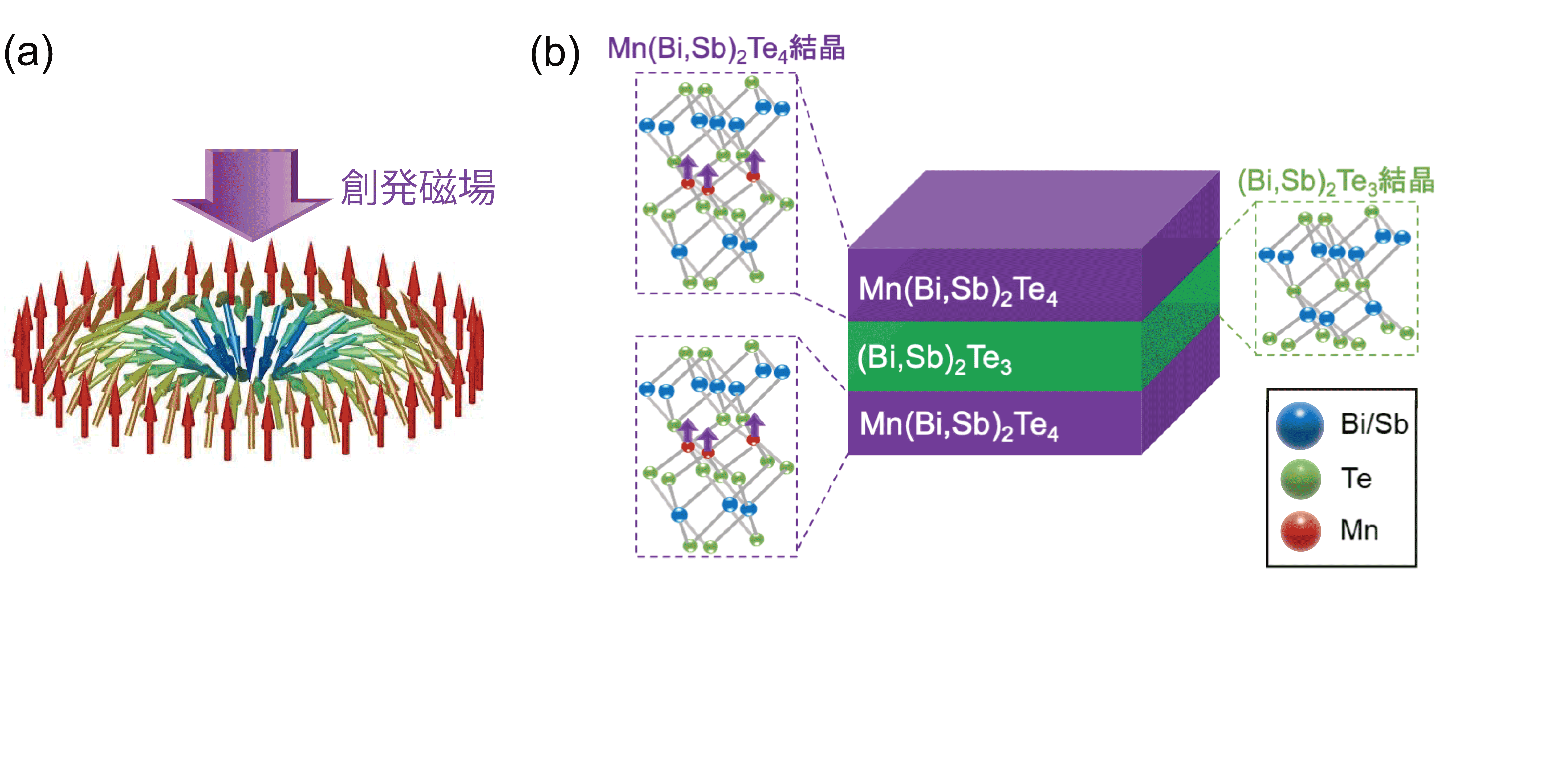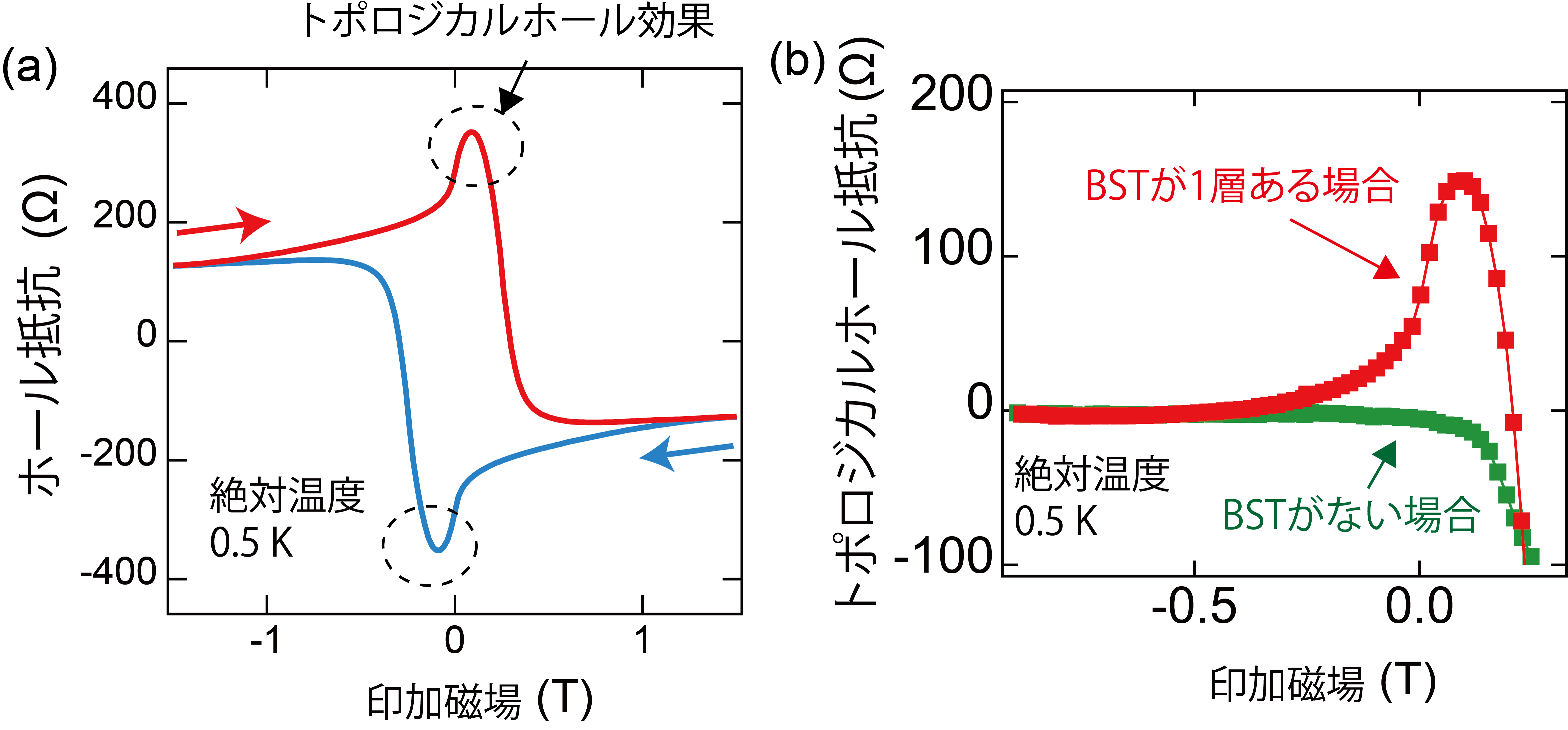DATE2022.01.28 #Press Releases
Discovery of magnetic vortices that can be generated and controlled in weak magnetic fields in a "topological atomic layer sandwich structure
Disclaimer: machine translated by DeepL which may contain errors.
Takuya Takagi (Department of Physics, 2nd Year Doctoral Student)
Ryota Akiyama (Assistant Professor, Department of Physics)
Shuji Hasegawa (Professor, Department of Physics)
Toru Hirahara (Associate Professor, Tokyo Institute of Technology)
Taisuke Sasaki (Senior Researcher, National Institute for Materials Science)
Key Points of the Presentation
- We have fabricated an "atomic layer sandwich structure" in which a topological insulator is sandwiched by a topological ferromagnet with magnetic atoms regularly arranged in a single atomic layer.
- It was observed electrically that a magnetic vortex (Skillmion (Note 1 )) was generated in a much weaker magnetic field than before.
- Skillmions, which do not break even when disturbed, can be controlled by weak magnetic fields and are expected to be applied to novel magnetic memories that can be easily rewritten.
Summary of presentation
A research group led by Graduate Student Takuya Takagi, Assistant Professor Ryota Akiyama, and Professor Shuji Hasegawa of the Department of Physics, Graduate School of Science, The University of Tokyo, and Associate Professor Toru Hirahara of the Graduate School of Science, The Tokyo Institute of Technology, in international collaboration with Senior Researcher Taisuke Sasaki of the National Institute for Materials Science and Professor A. A. Saranin of the Russian Academy of Sciences, has discovered a new type of spin (microscopic magnet) that is controlled by a weak magnetic field. The topological ferromagnet Mn(Bi,Sb) 2Te4(Note 2 ), which contains a single atomic layer of regularly arranged manganese atoms with spin (microscopic magnetic properties), has been used to fabricate an "atomic layer sandwich" structure with a topological insulator (Bi,Sb) 2Te3 atomic layer sandwiched on top and bottom. and measured its electrical conduction. As a result, the topological Hall effect (Note 3) was observed in a magnetic field as weak as 1/10th of the previous one, and the formation of microscopic magnetic vortices (skyrmions) (Note 1) was discovered.
In recent years, topological ferromagnets with atomic layers of regularly arranged magnetic atoms as described above have been actively studied worldwide, but this is the first observation of a skyrmion using the chiral spin structure of a topological insulator in this material system.
The skirmion discovered in this study is expected to contribute to the field of spintronics, as it does not break even under disturbance and can be applied to magnetic memory (Note 4), which can be easily rewritten under weak magnetic fields.
This research was published in Nano Letters, a journal of the American Chemical Society.
Publication details
Background of the research
Topological insulators are novel materials that behave like special metals with spin-aligned electrons flowing at high speeds on their surfaces, while their crystalline interiors do not conduct electricity, and have attracted much attention in recent years. This surface state is said to be "topologically protected," meaning that it is not destroyed by disturbances such as noise or impurities. This property is not only interesting from the viewpoint of fundamental physics, but is also strongly expected to be applied to next-generation electromagnetic devices.
More recently, the advantages of topological insulators have led to research that takes advantage of the spin of electrons. Topological ferromagnets," in which the properties of a magnet (ferromagnet) are introduced into a topological insulator, have been actively studied, and in particular, it is expected that the spin vortex (chiral spin state) of topological ferromagnets can be used to realize robust skyrmions (atomic magnets arranged in a nanoscale vortex) (Figure 1(a) ) It is expected that

Figure 1: (a) Schematic diagram of the magnetization of a skyrmion. The small arrows represent atomic magnets (magnetization), which form a virtual magnetic field (large arrows) when they are aligned in a spiral.
(b) Schematic of the "atomic layer sandwich structure" designed and fabricated in this research. The crystal structures of the topological insulator (Bi,Sb) 2Te3 and the self-assembled topological ferromagnet Mn(Bi,Sb )2Te4 are shown on the right and left sides, respectively.
Research Details
The research group designed and fabricated a nanoscale structure (Fig. 1(b)) in which the topological insulator BST atomic layer without magnetism is sandwiched between the top and bottom layers of MnBST, and succeeded in electrically observing a weak field-generating scirmion, which has never been realized in a self-assembled topological ferromagnet, through observation of topological Hall effect. The Hall effect is usually observed in ferromagnets.
Normally, the Hall effect in ferromagnetic materials is expressed as the sum of the "normal Hall effect," which is proportional to the applied magnetic field, and the "anomalous Hall effect," which is proportional to the magnetization strength. On the other hand, in ferromagnetic materials that express a skyrmion, it is necessary to take into account the "topological Hall effect," which depends on the strength of the virtual magnetic field (emergent magnetic field) induced by the skyrmion. In fact, in the present study, a hump-shaped increase in Hall resistance was observed in the applied magnetic field region where a skyrmion vortex is formed, as shown in Figure 2(a), which is evidence of the topological Hall effect.

Figure 2: (a) Hall resistance in the sandwich structure observed in this study. The "hump-like" behavior as shown by the dotted circle is due to the topological Hall effect and indicates the presence of a scirmion. The red and blue arrows indicate the direction of change in the external magnetic field.
(b) Comparison of a sandwich structure with and without a BST layer, where a layer of BST is inserted between two MnBST layers to stabilize the skirmion and the topological Hall effect is observed.
Comparison of the case where a BST layer is inserted between two MnBST layers, as in a sandwich structure, and the case where no BST is inserted, reveals that topological Hall resistance is observed only when a BST layer is present (Figure 2(b)). This is evidence that the existence of a skyrmion is not stabilized by simply stacking two layers of MnBST, but only by "coupling" the magnetic topological surface states of the top and bottom surfaces of the BST layer in a sandwich structure.
Furthermore, in comparison with topological ferromagnets in which manganese atoms are added in a disorderly manner, which has been reported in the past, it was found that the observed SKYRMION can be produced with the application of a weak magnetic field of about 1/10 of the conventional one. This is thought to be due to the fact that the ferromagnetic interaction is strengthened by the regular and dense arrangement of manganese atoms at the atomic level through self-formation in this system, clearly indicating that the arrangement state of magnetic atoms has a significant effect on the skirmion properties.
Social Significance
This achievement demonstrates that the crystal structure and magnetism of topological ferromagnets are closely related, and contributes not only to the understanding of the fundamental physical properties of chiral spin-induced skillmions, but also to the future development of easily rewritable This will lead to the development of easily rewritable magnetic skirmion memories and other applications to next-generation spintronics devices.
Journal
-
Journal name Nano LettersTitle of paper Soft-Magnetic Skyrmions Induced by Surface-State Coupling in an Intrinsic Ferromagnetic Topological Insulator Sandwich StructureAuthor(s) Takuya Takashiro, Ryota Akiyama*, Ivan A. Kibirev, Andrey V. Matetskiy, Ryosuke Nakanishi, Shunsuke Sato, Takuro Fukasawa, Taisuke Sasaki, Haruko Toyama, Kota L. Hiwatari, Andrey V. Zotov, Alexander A. Saranin, Toru Hirahara, Shuji HasegawaDOI Number https://doi.org/10.1021/acs.nanolett.1c02952
Terminology
Note 1: Skyrmion
A nanoscale magnetic state in which the magnets (magnetization) of multiple atoms are arranged at an angle such that they exhibit a vortex-like order. It can be produced in the process of magnetization reversal in ferromagnetic materials when the conditions are met, and a virtual magnetic field (emergent magnetic field) is produced that depends on the size of the skirmion vortex. This type of skirmion is robust against disturbances due to its topologically protected magnetization arrangement, similar to that of a topological insulator. ↑up
Note 2 Topological ferromagnet
Topological insulators are a group of materials classified by the mathematical concept of topology, which has been demonstrated in many materials. Topological insulators are a group of materials classified by the mathematical concept of topology, which has been demonstrated in many materials. The interior of a solid does not conduct electricity, but on its surface, spin-aligned electrons can flow at high speeds. Electrons on the surface of a topological insulator are topologically protected and thus robust against external disturbances such as impurities, defects, and noise. Topological ferromagnets are materials that incorporate the properties of magnets into topological insulators, and have attracted much attention in recent years because they have been shown to exhibit novel electro-magnetic phenomena such as the quantum anomalous Hall effect, axion-insulating states, and skyrmions that reflect their unique surface electronic states (chiral spin states). The surface of the material is a very important element in the magnetic properties of the material. ↑up
Note 3 Topological Hall effect
When a magnetic field is applied to a solid material carrying an electric current, the Lorentz force causes the orbits of electrons to be bent in a direction perpendicular to both the magnetic field and the electric current, generating resistance in that direction (Hall resistance). The Hall resistance is proportional to the strength of the applied magnetic field (normal Hall effect). In ferromagnetic materials, magnetization (the alignment of microscopic magnets) plays a role in the magnetic field, bending electrons and generating Hall resistance. This is called the anomalous Hall effect, and its Hall resistance is proportional to the magnitude of the magnetization of the ferromagnetic material. Furthermore, in a material in which a skyrmion is present, the virtual magnetic field of the skyrmion vortex bends the electron orbits, generating the topological Hall effect. ↑up
Note 4 Magnetic memory
Memory elements that store information using the "charge" property of electrons are built into all kinds of electronic devices such as PCs, smartphones, TVs, and game consoles, and are indispensable in modern society. In the near future, however, magnetic memory devices are expected to be put to practical use, utilizing the "magnetic" properties of electrons to perform information operations such as rewriting and reading in accordance with the direction of a magnet. Skirmion is expected to be applied to magnetic memory devices because it can handle information such as the direction and size of vortexes, and in particular, its stability is expected to be used to develop memory devices with a low error rate and low information loss. ↑up
Note 5: Press release, June2, 2017.
Discovery of a New Method to Make Topological Insulators Ferromagnetic - Progress toward the Development of Devices Using the Quantum Anomalous Hall Effect -↑


